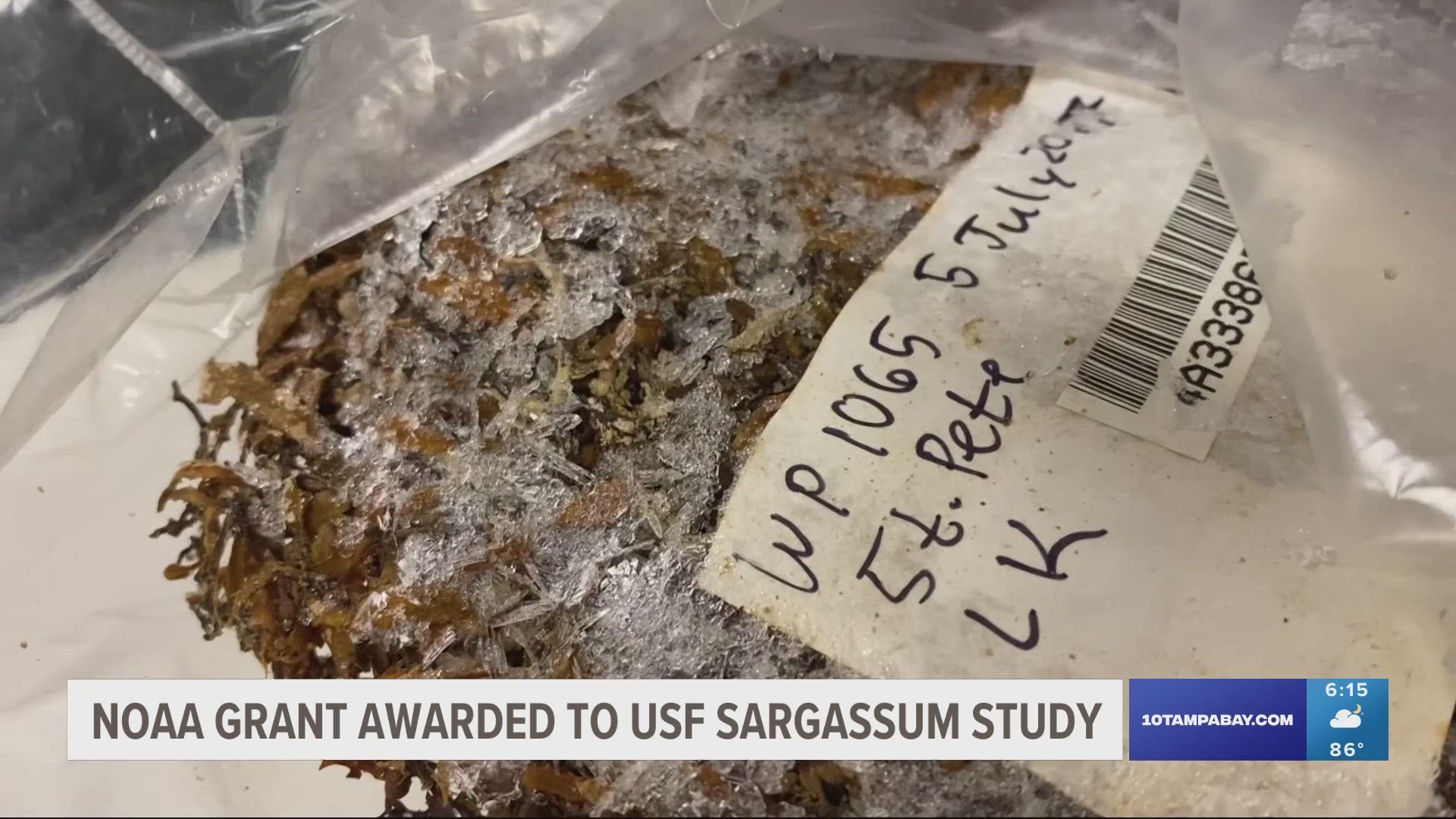TAMPA, Fla. — A $3.2 million grant will allow a team of researchers led by the University of South Florida's College of Marine Science to develop a sargassum forecasting system.
The team at USF will be able to "better forecast sargassum blooms" with this five-year grant from the NOAA Monitoring and Event Response for Harmful Algae Blooms program, a news release from USF explains.
It will also help prevent the blooms from plaguing coastal communities.
"In the open ocean, sargassum is a critical habitat for fish, turtles, and many other animals. So it's good," explained Dr. Chaunmin Hu, a professor and director of the CMS Optical Oceanography Lab, who is a part of the Sargassum forecasting project team.
Sargassum stays in the open ocean the vast majority of the time. But, more and more, Hu's research has shown it's ending up on our shores. While it's not an immediate threat, once the seaweed begins to decompose, it can become a health hazard.
"When you have too much on the beach in the Florida sunshine in two days, they will decompose," Hu said. "They smell so bad. They attract bacteria, insects. They grow virus and they smell like a rotten egg."
Half of the total funding will be given to USF while the remainder will reportedly be awarded to collaborators at Florida Atlantic University, the Caribbean Coastal Ocean Observing System, NOAA Atlantic Oceanographic and Meteorological Laboratory, and the U.S. Virgin Islands Department of Planning and Natural Resources.
“Up until this point, we have been using very coarse resolution satellite data to observe sargassum,” said Brian Barnes, assistant research professor and physical oceanographer at CMS, in a statement. “This grant will help us look at sargassum at a finer spatial scale, and this capability will eventually allow the scientific community to provide real-time monitoring and forecasting.”
Barnes will reportedly use satellite, hydrographic, and water-quality data to highlight the effects of Sargassum on coastal waters and beaches. This will help develop better forecasting solutions.
The ultimate goal is to increase how much researchers can monitor the blooms, the release explains.
“The College of Marine Science has tremendous expertise in the remote sensing arena and resident researchers are leading the way toward improved detection and monitoring of Sargassum blooms,” said Tom Frazer, professor and dean of CMS, in a statement. “A more precise Sargassum forecasting system will provide communities in Florida and the Caribbean advanced warning that their beaches may be impacted, and allow them to better prepare for an inundation event.
"This award demonstrates our faculty’s strength in coordinating collaborative research that has the potential for real-world impact."
Now, researchers can see the sargassum blooms via satellite. However, there is a gap in data along the coastlines. This grant will enable researchers to fill that gap, creating data that is hyper-specific with a forecast of 2-5 days out.
"What we really want to do with this project is to automate everything," Hu said. "So every day you have this type of product, high resolution started off some maps, and the forecast for next few days with updates every day."
Hu is one of a team of roughly 10 people working on this grant research at USF.
Back in 2019, a team of scientists led by the USF's College of Marine Science said it had discovered a giant seaweed bloom that wasn't going away anytime soon – and they were right.
Researchers say these massive mats of seaweed have been seen on satellite imagery since 2011 and have increased in density since then to form a huge belt of algae.
The massive seaweed belt allegedly forms "seasonally in response to two key nutrient inputs: one human-derived, and one natural."
Fast forward to 2023, the mass of sargassum seaweed reached a record-breaking size. But in July, USF reported it shrunk by 75 percent.
Researchers wrote that the sudden shrinkage in the month prior in June was "beyond expectation" after they saw only a slight decrease (about 15 percent) in the seaweed mass in May.
While it's not clear exactly what caused it to shrink, scientists say changes in nutrients, rainfall and wind conditions usually contribute to the fluctuating size of the mass.
Sargassum isn't harmful and is actually an important habitat for the sea life that have adapted to rely on the floating algae, such as shrimp, crab, sea turtles and tuna.
But it does emit a rotten egg-like odor, which stinks for beach tourism and local businesses that rely on it.
10 Tampa Bay's previous coverage contributed to this report.

